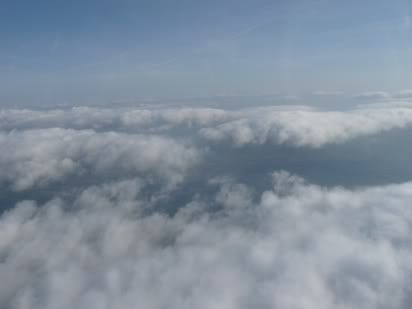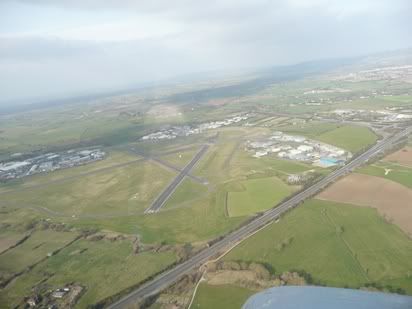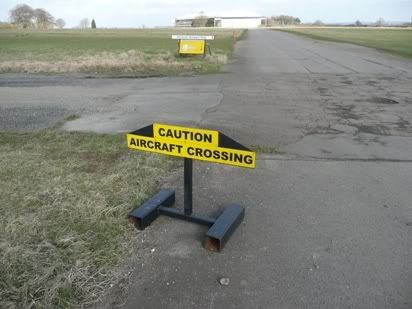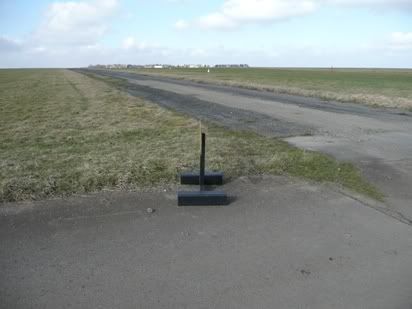The weather during the week had been appalling, strong winds and rain showers, but oddly it was always forecast to be calm and clear on Sunday. I awoke with my usual healthy degree of scepticism with UK weather forecasts, but in this case they got it right. OK, not quite clear skies, but scattered fluffy cumulus and best of all from a taildragging point of view, virtually nil wind!
I met up at the airfield with a fellow pilot (and on this occasion, self-loading ballast), Gavin, who has just returned to flying after three months off with a snapped Achilles tendon (nasty).
I had the route planned for weeks and had already checked the NOTAMs during the week, so we were good to go. The plan was to fly from Gloucester via DTY VOR then track towards Norwich airport, neatly slotting between Lakenheath and Marham MATZ’s to land first at Old Buckenham, then onto Tibenham a few miles away then back. All at FL40 if possible. I had planned the route some time ago and had all the changes of frequency marked, circuit directions, the lot. I called as requested for PPR and was told that there was intensive parachute activity at Old Buck and to call some ten miles from their ATZ.
The weight and balance with two of us bigger guys in did not make for happy reading, with room for a meagre, but entirely sufficient 70 litres, so we stuck 30 litres in at the pumps and took off on 27 at about 11:00.
My plan called for FL40, but it was either 3500’ odd or FL60 above the thick but broken cumulus. I opted for FL60 and called for a ‘basic service’ from Coventry. I was soon forced up to FL65. From earlier trips, I recalled a vague notion that there was controlled airspace around DTY at maybe FL55. A check on the map and it looked like we would easily miss it.
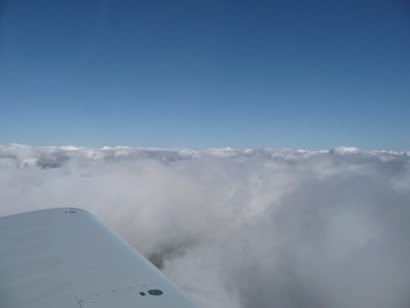
I still had a nagging doubt when Coventry called me and said if I continued on track at the current FL for another 5 miles, I would be in controlled airspace. Without hesitation, I confirmed a circling descent back to below the clouds at 3500’. Once established there, a close look at the map showed that I was right AND wrong (i.e. therefore wrong!). The bit I had spotted dropping into BHX would have been fine, but there was a small area of controlled airspace at FL55 right by the VOR. Lesson learned – plan the flight and fly the plan – always go through your long planned route on the day of the flight to refresh yourself on min / max altitudes etc. Some people now question ATSOCAS and debate the value of a ‘basic service’ – well, it certainly helped me on this occasion!
Abeam Northampton, I bade farewell to the helpful but relatively quiet Coventry and switched to a listening watch onto Lakenheath MATZ. Gavin and I were astonished at the apparently huge new ‘hard’ runway at Sywell / Northampton. I knew they had a planning application in, but I didn’t know they had built it now – wow!
We bumbled along at 3300’ odd keeping a sharp lookout for traffic. We saw some, usually below us and certainly no conflict. We were going to thread the gap between Lakenheath and Marham MATZ on a direct track to Norwich until some 15 miles to run, then turn SE to Old Buck.

As it turned out, I decided to orbit Shipdam at 3000’ whiole I called Old Buck for airfield information and the latest on para-dropping. They were OK for me to approach and suggested a downwind right join for 25. We started towards Old Buck, mindful that an overhead join was not allowed (one of the few occasions where I WOULD like an overhead join is at a new airfield!).
We both squinted and instinctively leaned forward to reduce the visual distance by about one foot (like you do!) to try to spot the airfield. It was probably lurking in the shadow of a cloud on an otherwise sunny day. I spotted where it must be and saw large buildings, but no runway. Then we spotted the Jodel that called a few minutes before us as I decided to slot in behind and follow him on the assumption that he knew where he was going! He certainly did as we spotted long sheds aligned with the correct runway heading, which on closer examination were obviously built on part of what must have been the HUGE original runway.
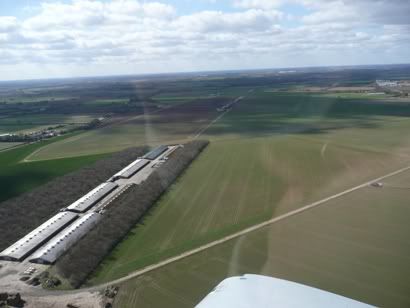
I was a bit too close to the Jodel so called that I was setting up for an orbit on final. That complete we resumed approach. The displaced threshold for 25 is VERY rough and we avoided that for a decent landing. The guy on the radio gave us very helpful taxi instructions to park on the very smooth and neatly mown grass.
We parked up and paid the landing fee, a very reasonable £10 IIRC. The café is basic but clean and with very prompt and friendly service. We took the bacon roll and tea outside to the picnic tables arranged on the grass overlooking the runway (very much like Compton Abbas, and Old Buck definitely reminded me of Compton somehow). It was such a perfect day and such a friendly and generally pleasant airfield, we both remarked that this was flying as it should be – friendly, unfussy and relaxed.
There was a lot of WW2 memorabilia and photos around, including of course James Stewart, who we the Executive Officer here for the Liberator group based here.

Their fuel bowser developed a few problems so I couldn’t refuel as planned. I did want to refuel here as the Flyer Forum fuel survey indicates that it has very reasonably priced fuel. Instead we mounted up somewhat reluctantly, having obtained PPR from Tibenham for the short hop some 5 nm away to Tibenham.
We departed on 25 and did a climbing right turn out of the ATZ to climb to some 2000’ to spot Tibenham. This we did easily as it has three huge black tarmac runways in the classic triangle arrangement. I called on the radio and got some information, basically to say they were using runway 33 for gliding. I approached and got myself oriented with the runways. There were cars and (as it turned out) a glider control cabin on runway 08/26, so clearly that was out, so I slotted in for runway 33 right hand downwind. I spotted a glider on final and was warned about this by the Radio. I continued until final and saw that the glider had come to a halt on the runway by the intersection with 08/26 and wasn’t moving. Then it dawned on me that of course gliders didn’t normally taxi off themselves, but needed man-handling – DOH! So I did a go around. At the same time, I heard another aircraft declare final and land on 03. Tibenham Radio suggested I did a right turn onto downwind for 03 and landed there instead. The windsock was barely moving so that is what I went for.
Man, the runways are HUGE! A decent landing had me down on 03 and the very helpful Radio operator gave me suggested taxi routing to hold by the gliding control cabin while they recovered the glider on 33. Once clear, I carried on and parked up outside the brick building near the clubhouse that turned out to be the AVGAS store.
We shut down and clambered out. There was some sort of MG rally going on as we inspected the poignant war memorial to the 445th US AAC Bombardment Group who flew Liberators from here in WW2 (again, along with the famous actor, James Stewart).

They were again very friendly and helpful in and outside the clubhouse. The glider towing pilot helped us to put 40 litres in the tanks (at a pretty expensive rate I have to say) and I settled up in the clubhouse.
This was only a flying visit as I said to another group member that I would try to get back by 16:00.
We mounted up and cleared the area, heading north to Shipdam then set a direct track to DTY at about 3400’.
We had a listening watch on Lakenheath as we sat happy as sandpipers at 3300’ below some very scattered and thin fair-weather cumulus. The trip back was uneventful, apart from an encounter with a glider not far from a gliding field (yes, that did alert me to keep a particular look out). I suspect we both saw each other as I skirted around him and he continued doing tight orbits, obviously trying for lift in a thermal.
Gloucester were still on a single combined frequency, so busy, but not frantically so. We got a standard overhead join for 27. Going crosswind, we spotted a PA28 in the circuit outside us to our left, so kept a close eye on him. We turned downwind in the usual place and he just kept going. I thought maybe he was departing the circuit. I called downwind only to then see him also turning ‘downwind’ waaaayyyyy outside us – I mean as bomber circuits go, this was mega! He HAD to have been outside the ATZ on the ‘downwind’ leg!
I turned base and called final. There was minimal wind. I made the mistake of coming in a little too fast this time. Well the RV will punish you for this with a very long floooooooaaaaaat! And so it did! I sat there feeling (and probably looking) like a numpty until the RV had humiliated me sufficiently with the tower and assembled onlookers and decided to sound the stall warner and deign to land. Bit of a bounce, nothing dramatic, then down. In the event, I didn’t go far past the intersection with runway 18 and was given a backtrack to vacate.
A great days flying in wonderful weather. I managed to take in two airfields I had not been to before and give myself a decent refresher on navigation and touring. Ready now for a spot of France with maybe some more UK-based ‘airfield collecting’.
